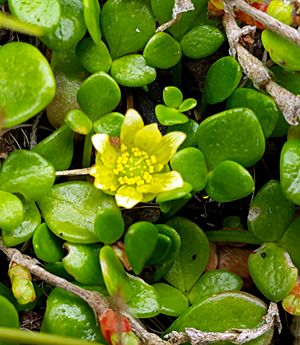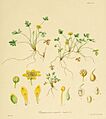Ranunculus acaulis facts for kids
Quick facts for kids Ranunculus acaulis |
|
|---|---|
 |
|
| Dune buttercup (Ranunculus acaulis) | |
| Scientific classification | |
| Genus: |
Ranunculus
|
| Species: |
acaulis
|
| Synonyms | |
|
|
The Ranunculus acaulis, often called dune buttercup, sand buttercup, or shore buttercup, is a small plant with yellow flowers. It is a fleshy herb that grows in thick mats in wet areas, usually close to the ocean.
You can find this plant naturally in Australia, New Zealand, Chile, and the Falkland Islands. It blooms (flowers) from August to April and produces seeds from September to July.
Contents
What Does the Dune Buttercup Look Like?
The dune buttercup is a small plant that lives for many years. It doesn't have any hairs on its leaves or stems. It grows in thick patches because many plants develop from its long, thin stems that spread above the ground.
Its leaves grow in a circle, like a rose. They are about 1 to 4.5 centimeters long and have a small stem. The leaves are thick, shiny, and have many tiny light dots. Each leaf is divided into three parts. The middle part is usually smooth or has three blunt teeth. The side parts are smooth or have one blunt tooth near the bottom.
The flowers are 7 to 10 millimeters wide. They grow one by one on stems that are about as long as the leaves. Each flower has three to five pale green or yellowish sepals, which are small leaf-like parts that protect the bud. These are about 1.5 to 2.5 millimeters long.
The flower has five to eight narrow yellow petals, which are about 5 millimeters long. Near the base of each petal, there's a small pocket-like part called a nectary. This is where the plant makes sweet nectar to attract insects.
Inside the flower, there are 10 to 20 yellow stamens, which are the parts that make pollen. These are arranged in about two circles around a raised green part called the receptacle. On top of the receptacle are six to twelve yellow carpels, which are the parts that will become seeds.
The seeds are inside small, dry fruits called achenes. When they are ripe, these fruits turn beige. They are oval-shaped, not flat, and have a slightly curved beak up to 1 millimeter long. The dune buttercup has 96 chromosomes in its cells.
Where Did the Name Come From?
The name Ranunculus comes from a Latin word, rana, which means "frog." Ranunculus means "little frog." This name probably refers to how some buttercup plants grow in wet places, just like frogs.
The second part of the name, acaulis, comes from two Greek words: "a-", meaning "without," and "kaulos", meaning "stalk" or "stem." This is because the flower of the dune buttercup grows on such a short stem that it looks like it doesn't have one at all!
Where Does the Dune Buttercup Live?
The dune buttercup is a native plant in New Zealand. It grows on both of New Zealand's main islands, as well as Stewart Island, Chatham Islands, and Auckland Islands.
In Australia, you can find it on the west and south coasts of Tasmania. In Chile, it lives in the areas of Los Rios, Los Lagos, Aisen, and Magallanes. It also grows on the Falkland Islands.
Images for kids
See also
 In Spanish: Ranunculus acaulis para niños
In Spanish: Ranunculus acaulis para niños



